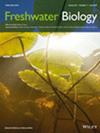Waterfowl Endozoochory: Traits Drive Plant–Bird Dispersal Interactions in North America
IF 2.7
2区 生物学
Q2 ECOLOGY
引用次数: 0
Abstract
- Plant biogeography and ongoing changes in plant distributions are influenced by long-distance dispersal (LDD) of seeds, and migratory waterfowl (Anatidae: Ducks, geese and swans) are particularly important for the dispersal of plants in and around wetlands through gut passage (endozoochory). However, this dispersal is not contemplated by classical dispersal syndromes; hence, currently we have limited understanding of what angiosperm traits predict seed dispersal by waterfowl and any differences due to avian trait variation among waterfowl species.
- We conducted a literature search for data on the presence of seeds in the alimentary canal or faeces of North American waterfowl as a proxy for dispersal interactions, since an important fraction of these seeds survives gut passage. We present a list of North American flowering plant species (N = 536) from 95 families potentially dispersed by 38 waterfowl species, together with traits of these plants and their vectors. Owing largely to limited sampling effort, 47% of plant species and 35% of plant genera recorded were only found in a single waterfowl species.
- A suite of analytical approaches revealed major differences in the traits of plants whose seeds are ingested and likely dispersed between foraging groups (guilds) and in relation to other waterfowl traits. Diving ducks and sea ducks are associated with sublittoral plants that have submerged or floating leaves, and hence with the classical hydrochory syndrome. Dabbling ducks and herbivorous waterfowl (notably geese) are associated with terrestrial herbaceous plants, and also with the unspecialised dispersal syndrome common in terrestrial plants. Plants with larger seeds or of greater height are more likely to be dispersed by dabbling ducks, whereas shorter plants are more likely to be dispersed by geese than by other waterfowl.
- Network analyses of interactions between waterfowl species and plant traits were generally consistent with these results, but also provided evidence that not all geese, dabbling ducks, or sea duck species are alike in their interactions with plants along the terrestrial–aquatic gradient, but instead occupy distinct dispersal niches. The traditional classification of waterfowl into guilds therefore does not accurately reflect their differing roles in the ingestion and dispersal of plant seeds. Aquatic plant species had more vector species than terrestrial ones.
- Detailed studies of waterfowl endozoochory and more trait determinations for North American plants are needed to facilitate predictions of LDD as waterfowl population sizes and migration patterns vary in the future with climate change.
水禽的内驱力:北美植物-鸟类扩散相互作用的特征驱动
植物生物地理和植物分布的持续变化受到种子长距离传播(LDD)的影响,而迁徙的水禽(鸭、鹅和天鹅)对植物通过肠道在湿地内外的传播尤为重要。然而,经典的扩散综合征并没有考虑到这种扩散;因此,目前我们对被子植物性状如何预测水禽的种子传播以及水禽物种间性状变异的差异了解有限。我们对北美水禽消化道或粪便中种子的存在进行了文献检索,作为传播相互作用的代理,因为这些种子的重要部分在肠道中存活。本文报道了38种水禽可能传播的北美95科开花植物(N = 536种)的特征及其媒介植物。主要由于取样努力有限,47%的植物种类和35%的植物属仅在单一水禽物种中发现。一套分析方法揭示了种子在觅食群体(行会)之间被摄入和可能传播的植物的性状以及与其他水禽性状的关系的主要差异。潜水鸭和海鸭与具有水下或漂浮叶子的海下植物有关,因此与经典的水栖综合征有关。涉水鸭和食草水禽(尤其是鹅)与陆生草本植物有关,也与陆生植物常见的非特化扩散综合征有关。种子较大或高度较高的植物更有可能被涉水鸭传播,而较短的植物更有可能被鹅而不是其他水禽传播。水禽物种与植物性状之间相互作用的网络分析与这些结果基本一致,但也提供了证据表明,并非所有的鹅、涉水鸭或海鸭物种在与陆地-水生梯度上的植物相互作用中都是相似的,而是占据不同的分散生态位。因此,将水禽划分为行会的传统分类并不能准确反映它们在摄取和传播植物种子方面的不同作用。水生植物的病媒生物种类多于陆生植物。由于水禽种群规模和迁徙模式在未来随着气候变化而变化,因此需要对水禽的内源性进行详细研究,并对北美植物进行更多的性状测定,以促进对LDD的预测。
本文章由计算机程序翻译,如有差异,请以英文原文为准。
求助全文
约1分钟内获得全文
求助全文
来源期刊

Freshwater Biology
生物-海洋与淡水生物学
CiteScore
5.90
自引率
3.70%
发文量
162
审稿时长
2 months
期刊介绍:
Freshwater Biology publishes papers on all aspects of the ecology of inland waters, including rivers and lakes, ground waters, flood plains and other freshwater wetlands. We include studies of micro-organisms, algae, macrophytes, invertebrates, fish and other vertebrates, as well as those concerning whole systems and related physical and chemical aspects of the environment, provided that they have clear biological relevance.
Studies may focus at any level in the ecological hierarchy from physiological ecology and animal behaviour, through population dynamics and evolutionary genetics, to community interactions, biogeography and ecosystem functioning. They may also be at any scale: from microhabitat to landscape, and continental to global. Preference is given to research, whether meta-analytical, experimental, theoretical or descriptive, highlighting causal (ecological) mechanisms from which clearly stated hypotheses are derived. Manuscripts with an experimental or conceptual flavour are particularly welcome, as are those or which integrate laboratory and field work, and studies from less well researched areas of the world. Priority is given to submissions that are likely to interest a wide range of readers.
We encourage submission of papers well grounded in ecological theory that deal with issues related to the conservation and management of inland waters. Papers interpreting fundamental research in a way that makes clear its applied, strategic or socio-economic relevance are also welcome.
Review articles (FRESHWATER BIOLOGY REVIEWS) and discussion papers (OPINION) are also invited: these enable authors to publish high-quality material outside the constraints of standard research papers.
 求助内容:
求助内容: 应助结果提醒方式:
应助结果提醒方式:


